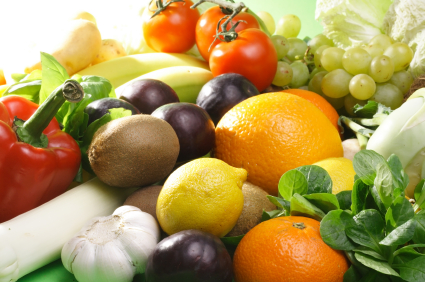 The National Cancer Institute recommends that we eat 5 to 9 servings of fruits and vegetables each day. But in this fast world of ours of shuffling between work, kids’ sports and after school activities and all, our foods tend to be convenience foods: fast food or just frozen pre-packaged convenience foods.
The National Cancer Institute recommends that we eat 5 to 9 servings of fruits and vegetables each day. But in this fast world of ours of shuffling between work, kids’ sports and after school activities and all, our foods tend to be convenience foods: fast food or just frozen pre-packaged convenience foods.
Although the benefits of eating the recommended daily servings of fruits and vegetables are clear, with studies showing the likelihood of reduced risks of diseases, most of Americans still do not ingest anywhere near the recommended amounts.
The Center for Disease Control (CDC) states that, compared with people who consume a diet with only small amounts of fruits and vegetables, those who eat more generous amounts as part of a healthful diet are likely to have reduced risk of chronic diseases, including stroke and perhaps other cardiovascular diseases, and certain cancers. They even have a cool tool on their site that you can plug your age, activity level and gender into to find out your personalized recommendation. To try it out, click here.
Yet, according to the Western Growers Association, Americans spend $165 per person on fresh produce every year, which equates to about 300 pounds of fresh fruits and vegetables per year.
 On the flip side, here are some shocking facts about fast food in our country, cited from the book, FAST FOOD NATION (written by Eric Schlosser):
On the flip side, here are some shocking facts about fast food in our country, cited from the book, FAST FOOD NATION (written by Eric Schlosser):
- This year Americans will spend over $110 billion on fast food more than they’ll spend on movies, books, magazines, newspapers, videos, and recorded music combined.
- Every day about one quarter of the U.S. population eats fast food.
- American children now get about one quarter of their total vegetable servings in the form of potato chips and French fries.
- The typical teenage boy in the United States now gets about 10% of his daily calories from soda.
- The rate of obesity among American children has doubled since the late 1970s.
- A fast food soda that sells for $1.29 costs the restaurant about ten cents, a markup of more than 1200 percent.
It’s so obvious that most Americans DON’T get the recommended daily allowance, that there are even commercials on television pointing this fact out (think V8 Fusion). The fact is that there are very simple and affordable ways to up your intake of the recommended fruits and vegetables.
Here are five simple and easy to implement tips to help you and your family reduce the fast food and increase in intake of “nature’s fast food” a.k.a. fruits and vegetables:
- FIND YOUR LOCAL FARMERS MARKET on www.fillyourplate.org to purchase farm-fresh, healthy fruits and vegetables
- BUY IN-SEASON PRODUCE FROM YOUR LOCAL GROCERY STORE. Not only is it likely to have come from a local farmer, but it’s likely to be fresher than the out-of-season produce offered.
- PLAN AHEAD. Meal planning is a hugely important step to changing your habits. You can plan your meals after your shopping trip to the farmers market or grocery store and even prepare some meals in advance and freeze them for easy reheating during the week. There are tons of great recipes on www.fillyourplate.org that are very family-friendly. There are also entire weeks of menus offered on the Arizona Farm Bureau’s website like this one here that offer plentiful servings of fruits and veggies that are also very affordable.
- BE CONSCIOUS of what you are eating. Most of us just grab at the closest filling food when hungry and on the run. By pre-packing a bag with fruits and veggies that are easy to munch on, such as oranges, apples, carrots and grapes, you can quickly grab it and bring it where your schedule brings you.
- MAKE IT FUN and plan a trip to a local farm where you can pick your own items. By involving the whole family in the process, you can increase the interest in eating it! Visit www.fillyourplate.org to find a comprehensive listing of nearby farms and orchards.
Following these simple steps will not only help your family’s heath, but your budget also. Not only are you increasing the much-needed nutrients to keep your family healthy, but by keeping money with the local farmers, you are ensuring a healthy supply of fresh produce and meats. Buying from local farmers and farmers markets stimulate the economy on a local level. The best payoff? You’re making a small investment in the future of your health, and your children’s as well. So buy more fruits and vegetables—your health will thank you for it!
To read the previous article in this series, click here.
Arizona Farm Bureau is a grassroots organization dedicated to preserving and improving the Agriculture industry through member involvement in education, political activities, programs and services.
For more information contact Julie Murphree at (480) 635-3607 or go to http://www.azfb.org.


Pingback: The New Steak Diet: How to Eat Beef and Still Lose Weight «
Pingback: Healthy Eating Series: Top 10 “All You Can Eat Foods & Still Lose Weight «
Pingback: Food Check-Out Week Spotlights Healthy Eating on a Budget «
Pingback: Healthy Eating Series: It’s All in the Preparation… «
Pingback: It’s Not How Far You Have to Go to Get Healthy Food, It’s How Much it Costs When You Get There | Fill Your Plate Blog